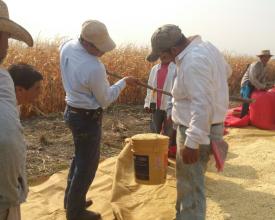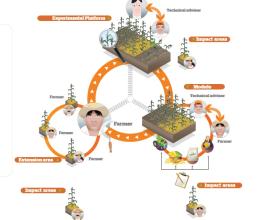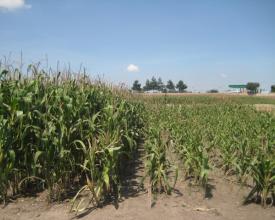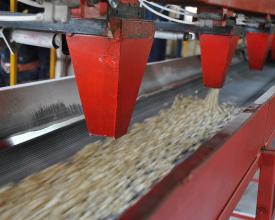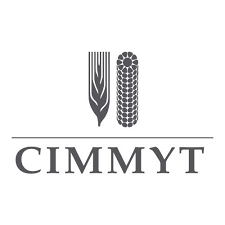
MasAgro: CIMMYT and Mexico's partnership for sustainable maize production
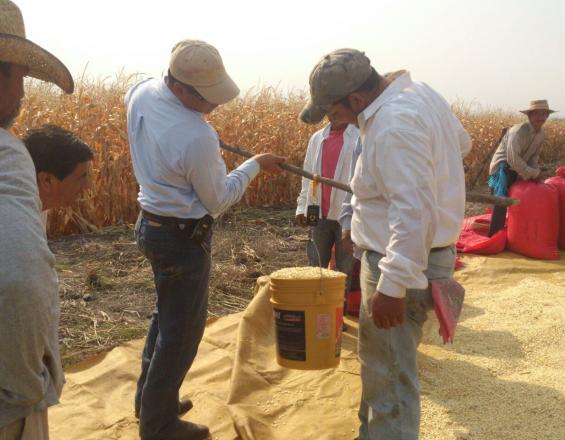
The CIMMYT-led project MasAgro develops farmers’ ability to adopt the product of research on maize conservation and improvement, agronomy, machinery, ICTs and postharvest solutions. MasAgro has developed 49 improved maize varieties adapted to small scale farming in Mexico. Farmers and breeders collaborate to improve native maize yield potential and its resistance to diseases. Improved seeds and conservation agriculture have helped farmers increase yields and keep them above the national average. Participating farmers achieved, on average, a 25% increase in both yields and annual revenue. More than 30 local seed companies sold 1.1 million bags of improved seed in 2017, a combined market share of 21%. For every dollar invested participating farmers make $7. This strategy can be replicated in trainings, participatory maize improvement, or more ambitious breeding and capacity building projects.
Context
Challenges addressed
Agriculture contributes significantly to greenhouse gas (GHG) emissions. Conservation agriculture (CA) based on minimal soil disturbance, permanent ground cover and crop rotations reduces GHG emissions. CA improves water infiltration and moisture retention in the ground, conserves soil fertility and health, and increases farmers’ productivity and income. In Mexico’s highlands, where CIMMYT has been running a field trial since 1991, CA has a lower global warming potential (GWP) than conventional tillage (CT). During the last drought in the region (2009), the GWP (including soil carbon sequestration, GHG emissions, fuel use and fertilizer) of maize grown under CA was -7,729 kg CO2 per hectare compared to 1,327 kg CO2 per hectare of maize grown under CT. Soil water content stayed above or near wilting point during the whole dry period under CA, whereas soil water values were below wilting point for three weeks under CT. Yields were up to 4.7 tons per hectare higher under CA than under CT.
Location
Process
Summary of the process
CIMMYT and SAGARPA are implementing MasAgro to help address maize production, biodiversity conservation, food security and sustainable rural development challenges. MasAgro develops a sustainable intensification strategy of maize production systems based on conservation agriculture, and on the development and transfer of improved, high-yielding, climate ready maize seeds to farmers’ fields. MasAgro develops small farmers’ ability to adopt the product of CIMMYT’s research on maize conservation and improvement, agronomy, farming machinery, information and communication technologies (ICTs), and postharvest storage solutions. CIMMYT has developed innovation networks or hubs between maize farmers, researchers, service providers, extension agents, authorities, local seed producers and industry representatives in 12 regions of Mexico that have specific agronomic, ecological, weather, infrastructure and market conditions relevant to maize production. MasAgro offers training to extension agents, technicians and farmers who maintain an ongoing exchange of information that has been key to achieve resource conservation and use efficiency, productivity gains and income increases.
Building Blocks
Sustainable Intensification
MasAgro is in its seventh year of implementation developing a sustainable intensification strategy of maize production systems based on conservation agriculture, and on the development and transfer of improved, high-yielding, climate ready maize seeds to farmers’ fields. MasAgro develops small farmers’ ability to adopt the product of CIMMYT’s research on maize conservation and improvement, agronomy, farming machinery, information and communication technologies (ICTs), and postharvest storage solutions. CIMMYT has developed innovation networks or hubs between maize farmers, researchers, service providers, extension agents, authorities, local seed producers and industry representatives in 12 regions of Mexico that have specific agronomic, ecological, weather, infrastructure and market conditions relevant to maize production. Each hub is formed by research platforms, demonstration modules, extension and impact areas where improved seeds, management systems, farming machinery and ICTs are developed, tested and adapted to farmers’ needs. MasAgro offers training to extension agents, technicians and farmers who maintain an ongoing exchange of information that has been key to achieve resource conservation and use efficiency, productivity gains and income increases.
Enabling factors
Each year MasAgro’s research infrastructure and impact areas depend on the type and number of participants, although SAGARPA provides core funding and CIMMYT leads R&D activities. CIMMYT and Mexico’s agricultural research system have bred and released 49 improved varieties of maize adapted to farming conditions in Mexico. CIMMYT has also offered training to more than 50 Mexican seed companies that commercialize the improved seed in target areas. Sustainable intensification helps farmers achieve the yield potential of the improved seeds.
Lesson learned
It is important to manage expectations of funding partners who are often eager to report outstanding results in terms of number of farmers reached or yield increases achieved. Agricultural research for sustainable development projects takes time to gain momentum, and to attract the attention of farmers who are often skeptical about new agricultural practices or disappointed by publicly funded programs that have failed in the past. Farmers are often reluctant to innovate because they have much at stake. If a crop cycle fails they loose their annual income so innovation must be gradual and participatory. MasAgro has succeded in overcoming risk aversion by promoting a gradual and incremental change on farmers' plots. Participant farmers first adopt sustainable intensification practices on a fraction of their land to compare its performance with the rest of the conventionally managed plot. In this way they also gain experience with sustainable farming and confidence to gradually extend the use of the new management system. Farmers must have access to expert advice to succeed.
Public - Private Partnerships
CIMMYT and more than 150 local and international partners from the public and private sectors participate in MasAgro’s research and development (R&D) activities and contribute to its implementation in the 12 hubs mentioned before. Each year, MasAgro’s research infrastructure and impact areas depend on the different type and number of participants, although SAGARPA provides core funding and CIMMYT leads most R&D activities. CIMMYT and Mexico’s agricultural research system (INIFAP) have bred and released 49 improved varieties of white maize and yellow maize that are adapted to small scale and rain-fed farming conditions in central, south and southeastern Mexico. CIMMYT has also offered specialized training to more than 50 Mexican seed companies that reproduce and commercialize the improved seed in MasAgro’s target areas. To help farmers adopt and achieve the yield potential of the improved maize varieties CIMMYT implements the sustainable intensification strategy described above.
Enabling factors
Public - private partnerships require a flexible approach to intellectual property rights. CIMMYT has been able to broker these partnerships for the benefit of thousands of farmers because the product of its research is free of intelectual property rights and has the status of universal public good, whether that may be improved seed, agronomic expertise, smart machinery prototypes or maize and wheat genotypes. Partners of an agreement of this nature must be willing to exchange information and to collaborate with each other.
Lesson learned
It takes time to develop an effective network of partners. Some local seed companies did not send back information of field trials or markets. They wanted to have access to improved maize lines adapted to the markets where they sold seed but were reluctant or unable to send back information needed to further select or identify the best materials. It became necessary to offer specialized training on seed production and marketing to local seed companies. It was also necessary to build trust in the research and development network, and to help representatives of individual companies identify new markets for their products. CIMMYT identified different regions of Mexico that could increase maize production by substituting landraces with new high-yielding and resilient seed. These medium to high potential conversion zones offered new markets and incentives to local seed companies participating in MasAgro. These activities have been matched with ongoing efforts to train farmers on the adoption of the new high-yielding seed so that they may achieve their full yield potential.
Impacts
Only in 2017, project partners and participants set up 52 research platforms, 1,468 demonstration modules of sustainable farming practices and 9,053 extension areas in 30 states of Mexico. MasAgro experts organized 2,099 field days to promote sustainable farming in 12 hubs. 33,348 farmers participated in these demonstration events. Furthermore, 5,935 technicians and extension agents attended MasAgro trainings. 40 technicians also completed a one year certification program and joined the 360 experts that CIMMYT has certified in sustainable agriculture since 2011. These technicians monitored sustainable farming practices in 1,390 demonstration modules and in 9,673 extension areas covering over 28,000 hectares. Information collected from the field was registered in MasAgro’s electronic logbook and added to the six-year (2011-2017) project database.
The latest data available shows that the productivity and income of participant farmers growing maize under rain-fed conditions was 92% and 105% higher, respectively, than average yields and income achieved by other farmers in Mexico. On average, rain-fed plots managed with MasAgro’s sustainable intensification practices yielded 25% more grain and revenue to maize farmers than plots managed with conventional practices on the same farm. Similarly, Mexican seed companies have increased 70% their sales of improved seed since 2011.
Beneficiaries
MasAgro has had a positive impact on the lives of more than 300,000 farmers who have adopted conservation agriculture and sustainable farming technologies on 1.3 million hectares to grow 49 maize varieties bred for rain-fed conditions across Mexico.
Sustainable Development Goals
Story
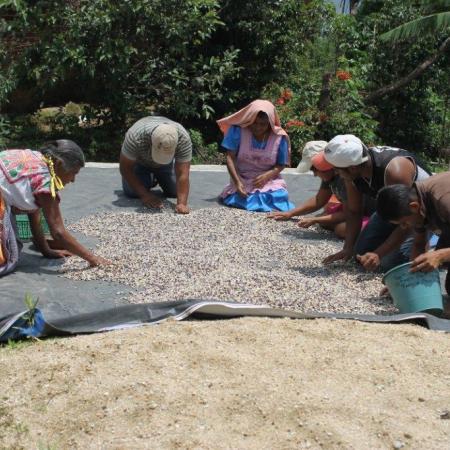
CIMMYT conserves and improves biodiversity in communities of Oaxaca and the Yucatan Peninsula where subsistence farmers grow native maize. In 2017, MasAgro conducted 38 participatory native maize breeding trials in 12 indigenous communities of Oaxaca. Local farmers, CIMMYT and INIFAP breeders collaborated to improve native maize yield potential and its resistance to prevalent diseases, such as the tar spot complex which causes yield losses of up to 90%. CIMMYT is also repatriating maize landraces at risk in the Yucatan Peninsula where farmers in search of better opportunities stop growing native varieties. CIMMYT partnered with the Mérida-based Mayan World States Foundation to help farmers realize a better price for their produce in established and new markets. Top chefs in Mexico, Europe and the U.S. have sourced grain from small farmers in Oaxaca and the Yucatan Peninsula including Enrique Olvera (Cosme, NYC, and Pujol, Mexico City) and Rene Redzepi (noma, Copenhagen) .
